 Technology peripherals
Technology peripherals
 AI
AI
 Erase blemishes and wrinkles with one click: in-depth interpretation of DAMO Academy's high-definition portrait skin beauty model ABPN
Erase blemishes and wrinkles with one click: in-depth interpretation of DAMO Academy's high-definition portrait skin beauty model ABPN
Erase blemishes and wrinkles with one click: in-depth interpretation of DAMO Academy's high-definition portrait skin beauty model ABPN
With the vigorous development of the digital cultural industry, artificial intelligence technology has begun to be widely used in the field of image editing and beautification. Among them, portrait skin beautification is undoubtedly one of the most widely used and most demanded technologies. Traditional beauty algorithms use filter-based image editing technology to achieve automated skin resurfacing and blemish removal effects, and have been widely used in social networking, live broadcasts and other scenarios.
However, in the professional photography industry with high thresholds, due to the high requirements for image resolution and quality standards, manual retouchers are still the main productive force in portrait beauty retouching. , complete a series of tasks including skin leveling, blemish removal, whitening, etc. Usually, the average processing time for a professional retoucher to perform skin beautification operations on a high-definition portrait is 1-2 minutes. In fields such as advertising, film and television, which require higher accuracy, the processing time will be longer.
Compared with skin resurfacing in interactive entertainment scenes, advertising-level and studio-level refined skin beautification brings higher requirements and challenges to the algorithm. On the one hand, there are many types of blemishes, including acne, acne marks, freckles, uneven skin tone, etc. The algorithm needs to adaptively process different blemishes; on the other hand, in the process of removing blemishes, the texture of the skin needs to be preserved as much as possible , texture, and achieve high-precision skin modification; last but not least, with the continuous iteration of photographic equipment, the image resolution commonly used in professional photography has reached 4K or even 8K, which poses great challenges to the processing efficiency of the algorithm. Stringent requirements.
Therefore, with the starting point of realizing professional-level intelligent skin beautification, we have developed a set of ultra-fine local image retouching algorithms ABPN for high-definition images. Very good results and applications have been achieved in clothing wrinkle removal tasks.
- ##Paper: https://openaccess.thecvf.com/content/CVPR2022/papers/Lei_ABPN_Adaptive_Blend_Pyramid_Network_for_Real-Time_Local_Retouching_of_CVPR_2022_paper.pdf
- Model & code: https://www.modelscope.cn/models/damo/cv_unet_skin-retouching/summary
##3.1 Traditional beauty algorithm
#The core of the traditional beauty algorithm is to make the pixels in the skin area smoother and reduce the conspicuousness of flaws, thereby making the skin look smoother. Generally speaking, existing beautification algorithms can be divided into three steps: 1) image filtering algorithm, 2) image fusion, and 3) sharpening. The overall process is as follows:

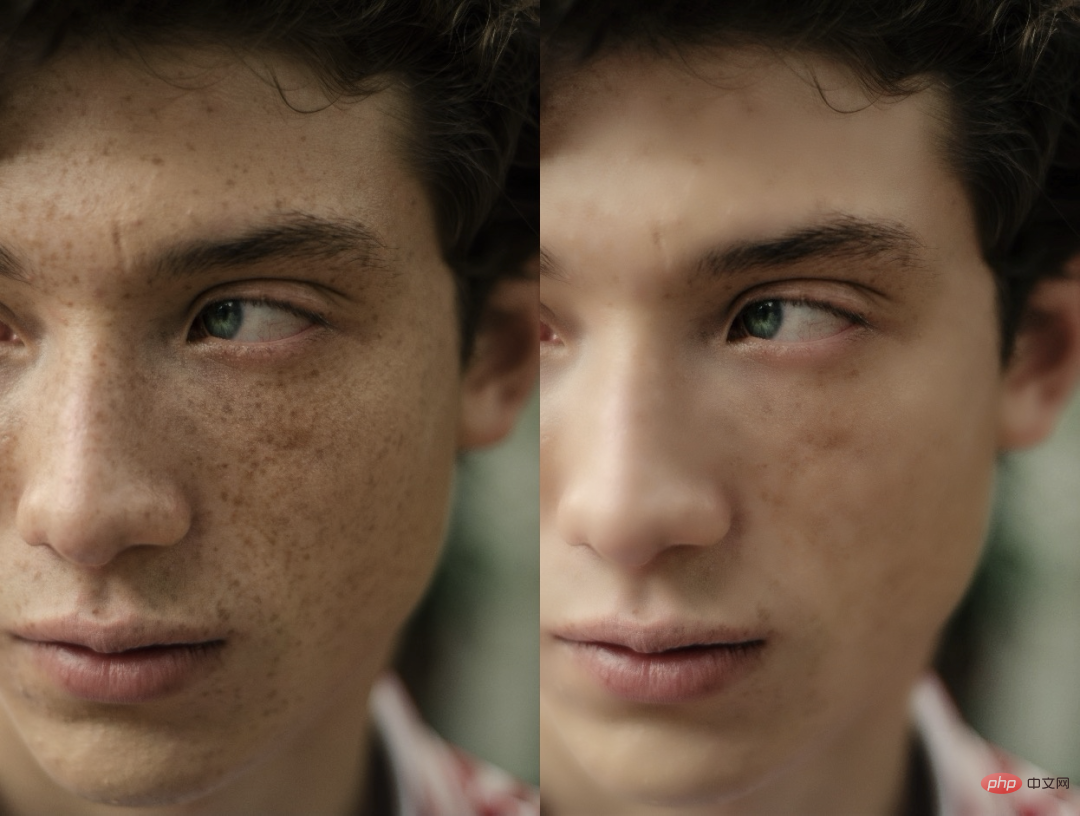
##The original image comes from unsplash [31]From the effect point of view, the traditional beauty algorithm has two major problems: 1) The processing of defects is non-adaptive and cannot handle different types of defects well. 2) Smoothing processing causes the loss of skin texture and texture. These problems are particularly noticeable in high-definition images.
3.2 Existing deep learning algorithm
In order to achieve adaptive modification of different skin areas and different flaws, based on Data-driven deep learning algorithms appear to be a better solution. Considering the relevance of the task, we discussed and compared the applicability of four existing methods: Image-to-Image Translation, Photo Retouching, Image Inpainting, and High-resolution Image Editing for skin beautification tasks.
- 3.2.1 Image-to-Image Translation
Image-to-Image Translation The task was initially started by pix2pix [1 ], which summarizes a large number of computer vision tasks into pixel-to-pixel prediction tasks, and proposes a general framework based on conditional generative adversarial networks to solve such problems. Based on pix2pix [1], various methods have been proposed to solve the image translation problem, including methods using paired images [2, 3, 4, 5] and methods using unpaired images. Methods [6,7,8,9]. Some work focuses on certain specific image translation tasks (such as semantic image synthesis [2, 3, 5], style transfer, etc. [9, 10, 11, 12]) and has achieved impressive results. However, most of the above image translations mainly focus on the overall transformation of image to image and lack attention to local areas, which limits their performance in skin beautification tasks.
- 3.2.2 Photo Retouching
##Benefiting from the development of deep convolutional neural networks, learning-based methods[ 13,14,15,16] has shown excellent results in the field of image retouching in recent years. However, similar to most image translation methods, existing retouching algorithms mainly focus on manipulating some overall properties of the image, such as color, lighting, exposure, etc. Little attention is paid to the retouching of local areas, and skin retouching is exactly a local retouching task (Local Photo Retouching), which requires retouching the target area while keeping the background area unchanged.
- 3.2.3 Image Inpainting
- 3.2.4 High-resolution Image Editing
Local retouching framework based on adaptive blending pyramid
The essence of skin beauty lies in the editing of images. Unlike most other image conversion tasks, this Editing is partial. Similar tasks include wrinkle removal on clothing and product modification. This type of local image retouching task has strong commonality. We summarize its three main difficulties and challenges: 1) Accurate positioning of the target area. 2) Local generation (modification) with global consistency and detail fidelity. 3) Ultra-high resolution image processing. To this end, we propose a local retouching framework based on Adaptive Blend Pyramid (ABPN: Adaptive Blend Pyramid Network for Real-Time Local Retouching of Ultra High-Resolution Photo, CVPR2022,[27]) to achieve ultra-high resolution For refined local retouching of images, we will introduce its implementation details below.
4.1 Overall network structure
As shown in the figure above, the network structure mainly consists of two parts: context-aware local modification layer (LRL) and adaptive blending pyramid layer (BPL). The purpose of LRL is to locally modify the downsampled low-resolution image and generate a low-resolution modification result image, fully considering the global context information and local texture information. Further, BPL is used to gradually upscale the low-resolution results generated in LRL to high-resolution results. Among them, we designed an adaptive blending module (ABM) and its reverse module (R-ABM). Using the intermediate blending layer Bi, we can achieve adaptive conversion and upward expansion between the original image and the result image, showing a powerful scalability and detail fidelity capabilities. We conducted a large number of experiments in the two data sets of facial modification and clothing modification, and the results show that our method is significantly ahead of existing methods in terms of effectiveness and efficiency. It is worth mentioning that our model achieves real-time inference of 4K ultra-high-resolution images on a single card P100. Below, we introduce LRL, BPL and network training loss respectively.
4.2 Context-aware Local Retouching Layer
In LRL, we Want to solve the two challenges mentioned in Part 3: precise positioning of the target area and local generation with global consistency. As shown in Figure 3, LRL consists of a shared encoder, mask prediction branch (MPB), and local modification branch (LRB).


In general, we use a multi-tasking structure to achieve explicit target areas Prediction,guidance with local modification. Among them, the structure of the shared encoder can use the joint training of the two branches to optimize features and improve the modification branch's global semantic information and local perception of the target. Most image translation methods use the traditional encoder-decoder structure to directly implement local editing without decoupling target positioning and generation, thus limiting the generation effect (the capacity of the network is limited). In contrast, multi-branch structures It is more conducive to task decoupling and mutual benefit. In the local modification branch LRB, we designed LAM (Figure 4), which uses the spatial attention mechanism and the feature attention mechanism simultaneously to achieve full fusion of features and capture of the semantics and texture of the target area. The ablation experiment (Figure 6) demonstrates the effectiveness of each module design.
4.3 Adaptive Blend Pyramid Layer
LRL is implemented at low resolution For local retouching, how to extend the retouching results to high resolution while enhancing its detail fidelity? This is the problem we want to solve in this part.
- 4.3.1 Adaptive Blend Module
##In the field of image editing, blending layers (Blend layer) is often used to mix with the image (base layer) in different modes to achieve various image editing tasks, such as contrast enhancement, deepening, and lightening operations, etc. Usually, given a picture , and a blending layer 
 , we can blend the two layers to get the image editing result , as follows:
, we can blend the two layers to get the image editing result , as follows: 

where f is a fixed pixel-by-pixel mapping function, usually determined by the blending mode. Limited by the conversion capability, a specific blending mode and fixed function f are difficult to be directly applied to a variety of editing tasks. In order to better adapt to the distribution of data and the conversion modes of different tasks, we drew on the soft light mode commonly used in image editing and designed an adaptive blending module (ABM), as follows:

represents Hadmard product, and are learnable parameters, which are used by all ABM modules in the network and the following Shared by the R-ABM module, represents a constant matrix with all values 1.
- 4.3.2 Reverse Adaptive Blend Module
, in order to obtain the hybrid layer B, we solve formula 3 and construct a reverse adaptive blending module (R-ABM), as follows:

In general, by using the mixed layer as an intermediary, the ABM module and the R-ABM module realize the adaptive conversion between the image I and the result R. Compared with directly using convolution on the low-resolution result Upsampling and other operations are expanded upward (such as Pix2PixHD). We use the hybrid layer to achieve this goal, which has two advantages: 1) In the local modification task, the hybrid layer mainly records the local part between the two images. Transform information, meaning it contains less irrelevant information and is easier to optimize by a lightweight network. 2) The blending layer acts directly on the original image to achieve the final modification, which can make full use of the information of the image itself, thereby achieving a high degree of detail fidelity.

In fact, there are many alternative functions or strategies for the adaptive hybrid module. We discuss the design motivation and other solutions in the paper. The comparison is introduced in detail and will not be elaborated here. Figure 7 shows the ablation comparison between our method and other hybrid methods.
4.3.3 Refining Module

##4.4 Loss function

5.1 Comparison with SOTA method

5.2 Ablation experiment
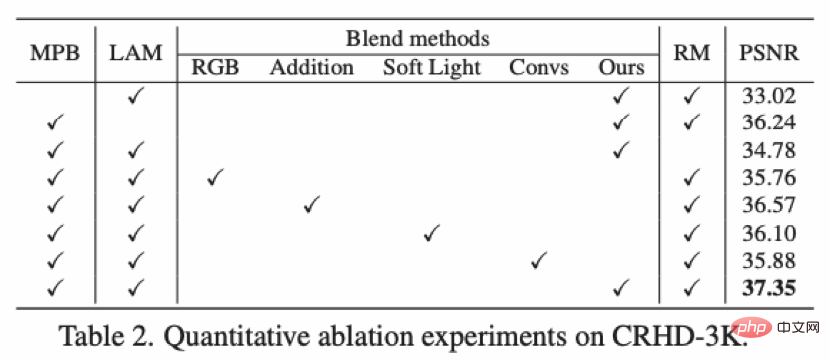
##5.3 Running speed And memory consumption
 Effect display
Effect display
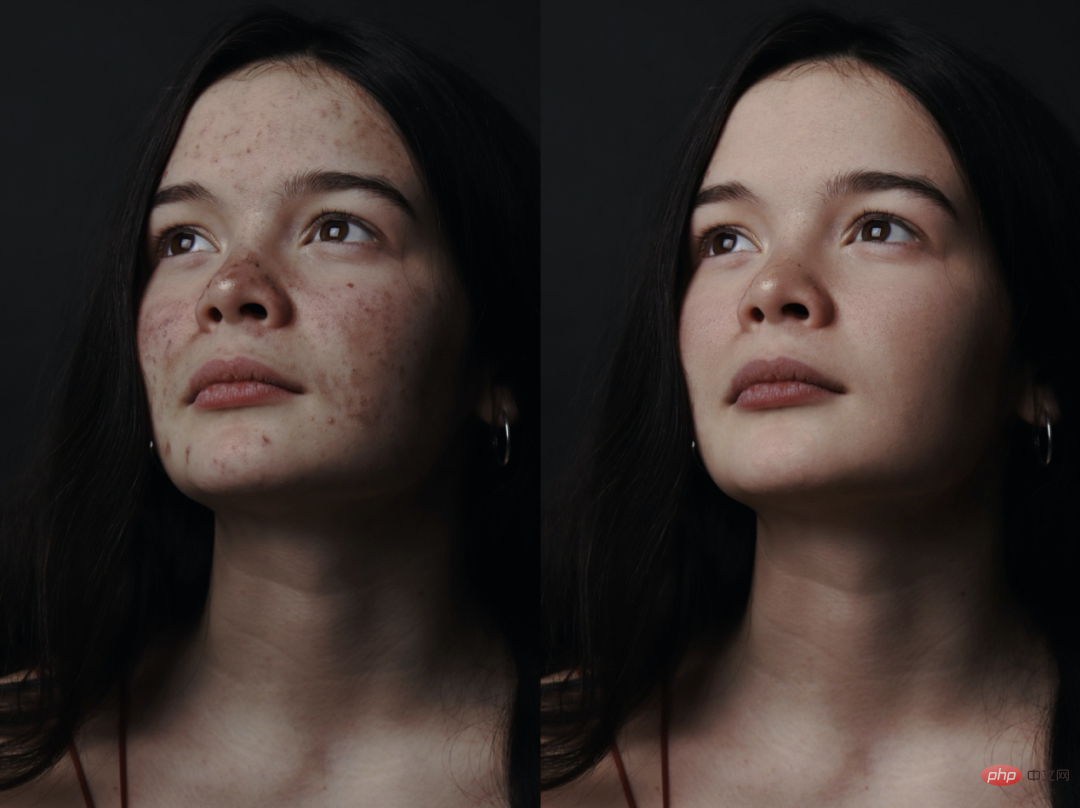
Original image from unsplash [31]
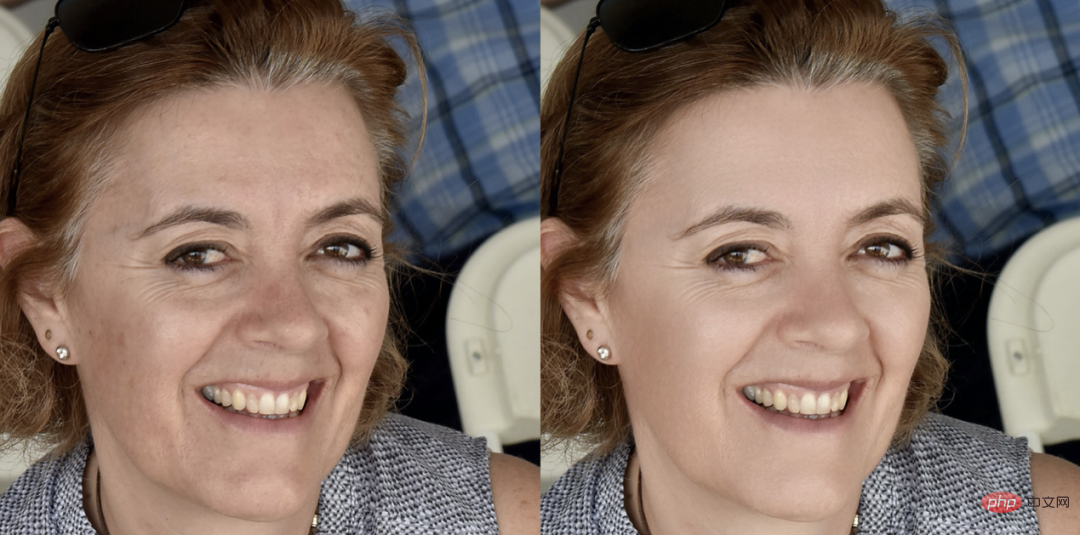
##The original image comes from the face data set FFHQ [32] It can be seen that compared with the traditional beauty algorithm, the local retouching framework we proposed fully retains the texture and texture of the skin while removing skin defects, achieving fine and intelligent Skin texture optimization. Further, we extended this method to the field of clothing wrinkle removal and achieved good results, as follows: 
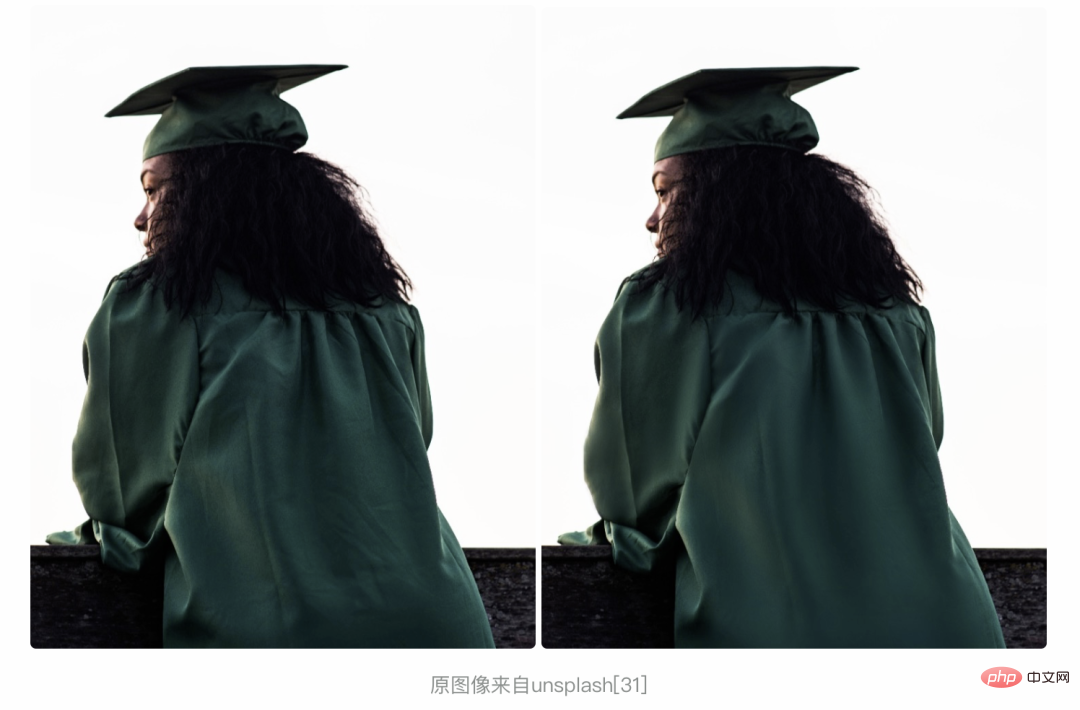
##
The above is the detailed content of Erase blemishes and wrinkles with one click: in-depth interpretation of DAMO Academy's high-definition portrait skin beauty model ABPN. For more information, please follow other related articles on the PHP Chinese website!

Hot AI Tools

Undresser.AI Undress
AI-powered app for creating realistic nude photos

AI Clothes Remover
Online AI tool for removing clothes from photos.

Undress AI Tool
Undress images for free

Clothoff.io
AI clothes remover

AI Hentai Generator
Generate AI Hentai for free.

Hot Article

Hot Tools

Notepad++7.3.1
Easy-to-use and free code editor

SublimeText3 Chinese version
Chinese version, very easy to use

Zend Studio 13.0.1
Powerful PHP integrated development environment

Dreamweaver CS6
Visual web development tools

SublimeText3 Mac version
God-level code editing software (SublimeText3)

Hot Topics
 1378
1378
 52
52
 How to implement file sorting by debian readdir
Apr 13, 2025 am 09:06 AM
How to implement file sorting by debian readdir
Apr 13, 2025 am 09:06 AM
In Debian systems, the readdir function is used to read directory contents, but the order in which it returns is not predefined. To sort files in a directory, you need to read all files first, and then sort them using the qsort function. The following code demonstrates how to sort directory files using readdir and qsort in Debian system: #include#include#include#include#include//Custom comparison function, used for qsortintcompare(constvoid*a,constvoid*b){returnstrcmp(*(
 How to optimize the performance of debian readdir
Apr 13, 2025 am 08:48 AM
How to optimize the performance of debian readdir
Apr 13, 2025 am 08:48 AM
In Debian systems, readdir system calls are used to read directory contents. If its performance is not good, try the following optimization strategy: Simplify the number of directory files: Split large directories into multiple small directories as much as possible, reducing the number of items processed per readdir call. Enable directory content caching: build a cache mechanism, update the cache regularly or when directory content changes, and reduce frequent calls to readdir. Memory caches (such as Memcached or Redis) or local caches (such as files or databases) can be considered. Adopt efficient data structure: If you implement directory traversal by yourself, select more efficient data structures (such as hash tables instead of linear search) to store and access directory information
 How to set the Debian Apache log level
Apr 13, 2025 am 08:33 AM
How to set the Debian Apache log level
Apr 13, 2025 am 08:33 AM
This article describes how to adjust the logging level of the ApacheWeb server in the Debian system. By modifying the configuration file, you can control the verbose level of log information recorded by Apache. Method 1: Modify the main configuration file to locate the configuration file: The configuration file of Apache2.x is usually located in the /etc/apache2/ directory. The file name may be apache2.conf or httpd.conf, depending on your installation method. Edit configuration file: Open configuration file with root permissions using a text editor (such as nano): sudonano/etc/apache2/apache2.conf
 How debian readdir integrates with other tools
Apr 13, 2025 am 09:42 AM
How debian readdir integrates with other tools
Apr 13, 2025 am 09:42 AM
The readdir function in the Debian system is a system call used to read directory contents and is often used in C programming. This article will explain how to integrate readdir with other tools to enhance its functionality. Method 1: Combining C language program and pipeline First, write a C program to call the readdir function and output the result: #include#include#include#includeintmain(intargc,char*argv[]){DIR*dir;structdirent*entry;if(argc!=2){
 How Debian OpenSSL prevents man-in-the-middle attacks
Apr 13, 2025 am 10:30 AM
How Debian OpenSSL prevents man-in-the-middle attacks
Apr 13, 2025 am 10:30 AM
In Debian systems, OpenSSL is an important library for encryption, decryption and certificate management. To prevent a man-in-the-middle attack (MITM), the following measures can be taken: Use HTTPS: Ensure that all network requests use the HTTPS protocol instead of HTTP. HTTPS uses TLS (Transport Layer Security Protocol) to encrypt communication data to ensure that the data is not stolen or tampered during transmission. Verify server certificate: Manually verify the server certificate on the client to ensure it is trustworthy. The server can be manually verified through the delegate method of URLSession
 Debian mail server firewall configuration tips
Apr 13, 2025 am 11:42 AM
Debian mail server firewall configuration tips
Apr 13, 2025 am 11:42 AM
Configuring a Debian mail server's firewall is an important step in ensuring server security. The following are several commonly used firewall configuration methods, including the use of iptables and firewalld. Use iptables to configure firewall to install iptables (if not already installed): sudoapt-getupdatesudoapt-getinstalliptablesView current iptables rules: sudoiptables-L configuration
 How to learn Debian syslog
Apr 13, 2025 am 11:51 AM
How to learn Debian syslog
Apr 13, 2025 am 11:51 AM
This guide will guide you to learn how to use Syslog in Debian systems. Syslog is a key service in Linux systems for logging system and application log messages. It helps administrators monitor and analyze system activity to quickly identify and resolve problems. 1. Basic knowledge of Syslog The core functions of Syslog include: centrally collecting and managing log messages; supporting multiple log output formats and target locations (such as files or networks); providing real-time log viewing and filtering functions. 2. Install and configure Syslog (using Rsyslog) The Debian system uses Rsyslog by default. You can install it with the following command: sudoaptupdatesud
 Debian mail server SSL certificate installation method
Apr 13, 2025 am 11:39 AM
Debian mail server SSL certificate installation method
Apr 13, 2025 am 11:39 AM
The steps to install an SSL certificate on the Debian mail server are as follows: 1. Install the OpenSSL toolkit First, make sure that the OpenSSL toolkit is already installed on your system. If not installed, you can use the following command to install: sudoapt-getupdatesudoapt-getinstallopenssl2. Generate private key and certificate request Next, use OpenSSL to generate a 2048-bit RSA private key and a certificate request (CSR): openss



